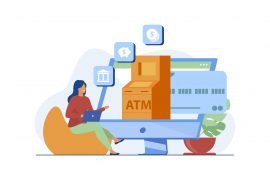Significant shifts in consumer behaviour create unique opportunities for Nordic merchants
There can be little doubt that the coronavirus pandemic has had an enormous and devastating effect on the global economy.

The use of cash has been steadily declining across the Nordics
But the pandemic also represents a unique opportunity because it has triggered significant shifts in consumer behaviour, which have not yet settled into new enduring patterns.
Now, the burning question on everyone’s mind is: what happens when the pandemic finally releases its grip on the world?
Analysis of comprehensive payment data and recent consumer research across the Nordic markets not only shows how the pandemic has affected consumer behaviour both online and offline, but it also provides insights into which of those trends are likely to continue.
New behaviours become new habits
Across the Nordics, the pandemic has shifted the balance between online and physical purchases, as well as the balance among e-commerce categories. The total online consumption in the Nordic countries decreased by SEK 218 billion compared with last year (down from SEK 856 billion to SEK 638 billion).
However, this drop is mainly driven by a sharp decline in travel spending. Online purchases of products have actually exploded. In all Nordic countries, the purchase of products now makes up more than half of all e-commerce transactions (Sweden 70%, Denmark 59%, Finland 58% and Norway 54%).
For physical purchases in the Nordics, the groceries category has experienced strong growth due to more consumers staying at home. Retail, restaurants, cafés and transport have experienced negative growth rates overall, in some cases as much as minus 47%.
But some sub-categories within these groups, such as flowers and home improvement, have grown significantly, again pointing to the significant changes among consumer patterns. The data also clearly shows a strong desire to return to physical shopping among all Nordic consumers.
It is also clear that the pandemic has driven cashless payments and accelerated consumer adoption of digital payment methods. In all Nordic countries, use of mobile, contactless and card payments have increased at the expense of cash, which is now preferred by less than 10% of all Nordic consumers.
Card is still the Nordic king of both physical and e-commerce payments, driven by the well-established card payment infrastructure. This payment method is preferred by up to 90% of Nordic consumers, mainly because it is considered easy, fast and secure.
There are three key opportunities more merchants should explore to grow their revenue and improve the customer experience as the world moves beyond the pandemic.
- Invest in stronger integration between online and physical sales channels
For years, the global business community has tried to crack the code of unified commerce, where online and physical sales channels integrate seamlessly. Now, there are many indications that the pandemic may have been a driving force in this direction.
On one hand, the widespread lockdowns and fears of infection motivated many consumers to turn to e-commerce when shopping for products, including older customer groups. A total of 22% of Nordic consumers say they are likely to shop online more often after the pandemic, with a fairly even distribution across all age groups. This indicates that more consumers have overcome significant barriers for shopping online, such as the force of habit and concerns about security.
However, most Nordic customers still prefer physical shopping and are eager to return to their favourite stores, restaurants and events. As many as two thirds of Nordic consumers prefer to shop physically versus online. One of the benefits of shopping in physical stores is the ability to see and feel the products before purchase, which 45% of Nordic respondents listed as their top reason for visiting a store.
Providing a strong, unified commerce experience is more important than ever before. The winners will be those who manage to provide a seamless experience designed around the customer’s preferences and needs.
For example, online shoppers have long since become accustomed to getting personal recommendations and offers based on data about their previous purchases and personal profile. In physical stores, this experience can be emulated by using mobile payment terminals, which set the sales staff free from the cash register.
This allows staff to accompany customers around the store to provide personal assistance. At hotels this allows guests to pay for room-service on delivery instead of adding it to their room bill for payment at check-out. In other words, meeting your customers where they are provides a better experience.
For customers who are more comfortable being in full control of their own buying experience, many companies have accelerated the implementation of click-and-collect programs and self-service checkout terminals to create a convenient and frictionless experience.
Digital receipts and loyalty programs are also excellent ways of combining physical and online shopping. Digital receipts can make returns easier, regardless of whether the purchase was made online or physically.
And loyalty solutions that provide benefits across multiple channels are an effective way for merchants to entice customers to visit both their digital and physical locations. Almost half of Nordic consumers prefer digital receipts and roughly nine out of ten are part of at least one loyalty program.
- Offer a variety of digital payment options
With the steady decline of cash, which has been going on for years in the Nordics and was accelerated by the pandemic for hygiene reasons, it is increasingly vital for businesses to provide digital payment options to accommodate cash-free purchases.
For example, 26% of Swedes never use cash, which is the highest percentage in the Nordics. However, there is far from a universal consensus about digital payment preference across the channels among Nordic consumers.
Providing a comprehensive suite of digital payment options is good business sense. Lack of a preferred payment option is the second most significant reason for dropped online purchases. 37% of Nordic consumers have interrupted a purchase online, and almost one out of ten online purchases were lost because the customer’s preferred payment option was not available. This also applies to physical sales, where a lack of a preferred payment option also results in lost sales.
In 28% of the abandoned purchases, Nordic consumers had to interrupt a purchase because a business only accepted cash and all they had was a card. It’s also worth noting that in 7% of the cases, the lack of a “buy now, pay later” option resulted in a lost purchase.
In the Nordics, card payment is still a major factor in both physical and e- commerce, but other digital options such as mobile payments are slowly gaining ground. Contactless payment continues to rise in popularity among Nordic consumers. In 2020 alone, contactless payment increased from 44% to 62%.
- Keep international consumer preferences in mind
As travel restrictions lift, physical businesses can also expect an increase in international customers. In this respect, merchants should be aware that the Nordics are among the most digitalised markets in the world and that consumer payment preferences vary significantly across different countries.
Most visitors prefer to use their local card such as UnionPay or Alipay for Chinese travellers and American Express for Americans. And in Germany and other parts of Europe, cash is more common than in the Nordics. So, if you cater to an international customer group, accepting several payment types becomes more important.
This variance in preference is even more relevant for e-commerce, where catering to an international customer group is obviously much easier. As a general rule of thumb, accepting card payments from the major international card providers like Visa or Mastercard is still the safest bet, but digital wallets, invoices and online bank transfers are also worth considering, depending on which countries the customers are from.
How can these insights add value and growth for Nordic merchants?
So, what does all this mean for Nordic businesses? First and foremost, consumer behaviour has changed in many ways during the pandemic. Customers will expect business to change as well to accommodate these new preferences, for example, by transforming their “points of sale” to “points of interaction” with more customer service options.
Providing a seamless experience across digital and physical channels through future-proof technology – unified commerce – will ensure that consumers are better served, and thus increases merchants’ growth opportunities.
Payment methods also need to be adapted to the consumer preferences. For physical purchases, accepting card payments is sufficient, but for online payments the picture is more varied. Cards are most important, but local mobile payment solutions like Swish, Vipps and MobilePay have also established a strong position online in the Nordics.











































